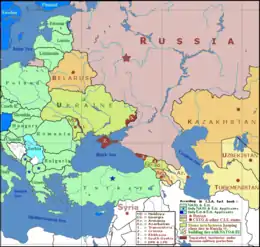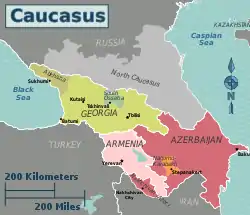Post-Soviet conflicts
This article lists the post-Soviet conflicts; the violent political and ethnic conflicts in the countries of the former Soviet Union following its dissolution in 1991.

Some of these conflicts such as the 1993 Russian constitutional crisis or the 2013 Euromaidan protests in Ukraine were due to political crises in the successor states. Others involved separatist movements attempting to break away from one of the successor states.
According to Gordon M. Hahn, the post-Soviet conflicts led to the death of at least 196,000 people, excluding pogroms and interethnic violence, between 1990 and 2013.[1]
Frozen conflicts
Some post-Soviet conflicts ended in a stalemate or without a peace treaty, and are referred to as frozen conflicts. This means that a number of former-Soviet states are left sovereign over the entirety of their territory in name only. In reality, they do not exercise full control over areas still under the control of rebel factions. Rebel groups are essentially left independent over large chunks of the territories they claim. In many instances, they have created institutions which are similar to those of fully fledged independent states, albeit with little or no international recognition. Notable such cases include Abkhazia and South Ossetia in Georgia; Nagorno-Karabakh on the border between Azerbaijan and Armenia; Transnistria in land near to Moldova's eastern border with Ukraine; and the Donetsk People's Republic and the Luhansk People's Republic breakaway areas in Ukraine.[2]
Recognition of these rebel groups varies. In some instances such as Transnistria, no UN-member state has given its recognition, including Russia. In the case of Georgia's Abkhazia and South Ossetia, Russia, Venezuela, Nicaragua, Nauru and Syria have recognized them.
Central Asia
| Conflict | Parties | Start | End | Detail | |
|---|---|---|---|---|---|
| Tajikistani Civil War | 5 May 1992 | 27 June 1997 | Began when ethnic groups from the Gharm and Gorno-Badakhshan regions of Tajikistan, which were underrepresented in the ruling elite, rose up against the national government of President Rahmon Nabiyev, in which people from the Leninabad and Kulab regions dominated. The war ended with the signing of the General Agreement on the Establishment of Peace and National Accord in Tajikistan and the Moscow Protocol.[3] | ||
| 2010 South Kyrgyzstan ethnic clashes | Ethnic Kyrgyz rioters Ethnic Uzbek rioters | 19 May 2010 | June 2010 | Clashes between ethnic Kyrgyz and Uzbeks in southern Kyrgyzstan, primarily in the cities of Osh and Jalal-Abad, in the aftermath of the ouster of former President Kurmanbek Bakiyev on April 7. | |
| Tajikistan insurgency | 19 September 2010 | September 2015 | Sporadic fighting in Tajikistan between rebel and government forces. | ||
| 2021 Kyrgyzstan–Tajikistan clashes | 28 April 2021 | 1 May 2021 | Clashes between Kyrgyzstan and Tajikistan over water dispute.[4][5] | ||
| 2022 Kazakh unrest | 2 January 2022 | 11 January 2022 | Protests across Kazakhstan that were sparked by an abrupt increase of gas prices, but have escalated into general protests. Kazakhstan's government has requested CSTO assistance in quelling the protests. | ||
North Caucasus

| Conflict | Parties | Start | End | Detail | |
|---|---|---|---|---|---|
| East Prigorodny conflict | 30 October 1992 | 6 November 1992 | Inter-ethnic conflict in the Eastern part of the Prigorodny district. | ||
| First Chechen War | 11 December 1994 | 31 August 1996 | Russian troops invaded after Chechnya declared independence, but withdrew in 1996 leading to a de facto Chechen independence. | ||
| War of Dagestan | 7 August 1999 | 14 September 1999 | The Islamic International Brigade invaded the neighbouring Russian republic of Dagestan in support of the Shura of Dagestan separatist movement. | ||
| Second Chechen War | 26 August 1999 | 31 May 2000 | Russia restores federal control of Chechnya. | ||
| Insurgency in Chechnya | 1 June 2000 | 16 April 2009 | Separatist insurgency in Chechnya, Dagestan, and other parts of the North Caucasus region. | ||
| War in Ingushetia | 21 July 2007 | 19 May 2015 | Separatist insurgency in Ingushetia. | ||
| Low-level insurgency in the North Caucasus | 16 April 2009 | 19 December 2017 | Separatist insurgency in Chechnya, Dagestan, and other parts of the North Caucasus region. | ||
South Caucasus
| Conflict | Parties | Start | End | Detail | |
|---|---|---|---|---|---|
| First Nagorno-Karabakh War | 20 February 1988 | 12 May 1994 | Ethnic Armenian separatism leads to the de facto independence of the Republic of Artsakh. | ||
| 1991–1992 South Ossetia War | 5 January 1991 | 24 June 1992 | The separatist conflict leads to South Ossetia's de facto independence. | ||
| Georgian Civil War | 22 December 1991 | 31 December 1993 | Inter-ethnic and intranational conflicts in the regions of South Ossetia and Abkhazia. | ||
| War in Abkhazia (1992–1993) | 14 August 1992 | 27 September 1993 | Abkhaz separatism leads to the de facto independence of Abkhazia from Georgia. | ||
| Nagorno-Karabakh conflict border skirmishes | 12 May 1994 | 27 September 2020 | Sporadic border war on the Armenian–Azerbaijan border and at the line of contact between the Nagorno-Karabakh and Azerbaijan. | ||
| War in Abkhazia (1998) | 18 May 1998 | 26 May 1998 | Ethnic Georgians launched an insurgency against the Abkhazian secessionist government. | ||
| Pankisi Gorge crisis | 2002 | 2004 | An incursion by Al-Qaeda forces on behalf of Chechen rebels fighting in the North Caucasus. They were forced out in 2004 by Georgian forces with American and Russian backing. | ||
| Rose Revolution | 3 November 2003 | 23 November 2003 | A peaceful revolution over threw President Eduard Shevardnadze in favor of Mikheil Saakashvili. | ||
| 2004 Adjara crisis | 23 November 2003 | 20 July 2004 | A popular revolt ousted the autocratic ruler Aslan Abashidze, Adjara reaffirmed its integration into Georgia as an autonomous republic. | ||
| Russo-Georgian War | 1 August 2008 | 12 August 2008 | A war between Georgia on one side and Russia, South Ossetia and Abkhazia on the other side confirms the de facto independence of Abkhazia and South Ossetia and leads to their recognition by Russia and Nicaragua.[6] | ||
| 2016 Nagorno-Karabakh conflict | 1 April 2016 | 5 April 2016 | Armenian and Azerbaijani forces fight a four-day long conflict along the border of the unrecognized Republic of Artsakh. Azerbaijani forces make minor territorial gains, some of which are retaken by Armenian forces before the end of the conflict. | ||
| July 2020 Armenian–Azerbaijani clashes | 12 July 2020 | 16 July 2020 | Armenian and Azerbaijani forces engage in border clashes along the Tavush Province of Armenia and Tovuz District of Azerbaijan. The death of Azerbaijani major general Polad Hashimov sparks the July 2020 Azerbaijani protests. Turkey and Azerbaijan organize large-scale military exercises following the clashes, and tensions persist until the beginning of the Second Nagorno-Karabakh war 2 months later. | ||
| Second Nagorno-Karabakh war | 27 September 2020 | 10 November 2020 | Azerbaijan retakes most of the territories previously controlled by the Republic of Artsakh. Russian peacekeepers introduced into the remaining disputed area. | ||
| 2021–2022 Armenia–Azerbaijan border crisis | 12 May 2021 | present | series of skirmishes along the Azerbaijan-Armenia border. | ||
Eastern Europe
| Conflict | Parties | Start | End | Detail | |
|---|---|---|---|---|---|
| Transnistria conflict | 2 September 1990 | — | Transnistria, de facto independent from Moldova, declared independence in 1990.[7] It is not recognized by the international community and there have been unsuccessful diplomatic attempts for solving the conflict. | ||
| Transnistria War | 1 March 1992 | 21 July 1992 | Most active and violent phase of the Transnistria conflict, the Transnistria War started due to fear from its Russian and Ukrainian-majority population to a unification with Romania. A ceasefire between Russian and Transnistrian forces and Moldovan forces has been in place since 1992, enforced by the presence of Russian forces in Transnistria.[7] | ||
| 1993 Russian constitutional crisis | 21 September 1993 | 4 October 1993 | Political stand-off between the Russian president and the Russian parliament that was resolved by using military force. | ||
| Orange Revolution | 22 November 2004 | 23 January 2005 | Amid allegations of voter fraud in the 2004 Ukrainian presidential election, supporters of candidate Viktor Yushchenko staged a peaceful civil uprising demanding a revote. The Supreme Court of Ukraine ultimately acceded to their demands and revoked the results, and Yushchenko won the resulting election. | ||
| Euromaidan and the Revolution of Dignity | 21 November 2013 | 22 February 2014 | Euromaidan is the name given to civil unrest that started when the Ukrainian government cancelled an association agreement with the EU in favour of closer ties with Russia, but was fueled by the perception of widespread government corruption, abuse of power and violation of human rights in Ukraine. The protests escalated and led to the Revolution of Dignity, which toppled the Ukrainian government. | ||
| Russo-Ukrainian War
|
20 February 2014
24 February 2022 |
— | In March 2014, following the takeover of Crimea by pro-Russian separatists and Russian Armed Forces,[8] a referendum (not recognised by the new Ukrainian authorities)[9] was held on the issue of reunification with Russia.[10] Russia then annexed Crimea. Then violent protests of the Russian population began in Donetsk and Luhansk Oblasts, which turned into a full-fledged war.
On 24 February 2022, the Russo-Ukrainian War escalated when Russian forces began bombing Ukrainian cities. After the bombings, Russian troops launched an operation on Ukrainian soil and began sending in troops on Ukrainian territory, launching a 'full-scale' invasion. This invasion was supported militarily by the Donetsk People's Republic and Luhansk People's Republic and non-militarily by Belarus. | ||
See also
References
- Hahn, Gordon M. (2017). Ukraine Over the Edge: Russia, the West and the "New Cold War". McFarland. ISBN 9781476628752.
- Rusif Huseynov. Ukraine: Towards a frozen future?: The Politicon, 11 November 2015
- Tajikistan Civil War Global Security
- "Kyrgyzstan, Tajikistan forces exchange gunfire in worst border flareup in years | Eurasianet". eurasianet.org. Retrieved 2021-04-29.
- Reuters Staff (29 April 2021). "Kyrgyz, Tajik security forces clash at border in water dispute". Reuters. Retrieved 29 April 2021.
- "Statement by President of Russia Dmitry Medvedev". Russia's President web site. 2008-08-26. Archived from the original on 2 September 2008. Retrieved 2008-08-26.
- "Trans-Dniester profile - BBC News". news.bbc.co.uk. Retrieved 2017-06-18.
- "Meeting of the Valdai International Discussion Club". Kremlin.ru. 2014-10-24. Archived from the original on 2015-04-15.
I will be frank; we used our Armed Forces to block Ukrainian units stationed in Crimea
- "Treasury Designates Seven Individuals And One Entity Contributing To The Situation In Ukraine". US Treasury. 11 April 2014.
- "Crimea applies to be part of Russian Federation after vote to leave Ukraine". The Guardian. 17 March 2014.